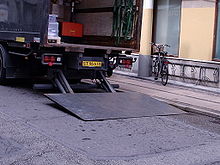Tail lift



A tail lift is a mechanical device permanently fitted to the back of van or lorry, which is designed to facilitate the materials handling of goods from ground level or a loading dock to the level of the load bed of the vehicle, or vice versa.
The majority of tail lifts are hydraulic or pneumatic in operation, although they can be mechanical, and are controlled by an operator using an electric relay switch.
The use of a tail lift can obviate the need to use machinery such as a forklift truck in order to load heavy items on to a vehicle, or can be used to bridge the difference in height between a loading dock and the vehicle load bed.
Tail lifts are available for many sizes of vehicle, from standard vans to articulated lorries, and standard models can lift anywhere up to 2500kg.[1]
Types
There are two key types of tail lift available to operators these are:
Column lifts
Column lifts are often mechanical, although they can be hydraulic or pneumatic. They run on 'tracks' fitted to the rear of the vehicle. From the tracks, a folding platform extends, which can be taken up and down.
Column lifts have the advantage of being able to lift to a higher level than the load bed (and are therefore suitable for loads over more than one level in the truck.[2] They are usually the easiest of the lift types to fit, as they require little structural work.
The disadvantages of column lifts include that the platform is only usually able to operate at a 90° angle from the track, meaning that on uneven surfaces, the lift will not meet the ground properly.
Cantilever lifts
The cantilever lift is the type first developed by Zepro. They operate only on a hydraulic or pneumatic system. The system works by a set of rams attached to the chassis of the vehicle. These rams are on hinges, allowing them to move angle as they expand or contract. By using the rams in sequence, the working platform can either be tilted, or raised and lowered.
Cantilever lifts have the advantage of being able to tilt, which means they can often form a ramp arrangement, which may be more appropriate for some applications. It also means that it can be easier to load or unload on uneven ground.
On tuckaway lifts, the ramp can be folded away under the load bed of the vehicle, leaving the option of it not being used when at a loading ramp, and giving access and egress for operatives without the need to operate the lift.
References
- ^ "Zepro Tail lifts product history". Retrieved 2007-06-05.
- ^ "Ratcliff Double Tier Lift" (PDF). Retrieved 2007-06-13.
